Siete qui:
- Home
- The MODO Museum
- Art and artists
- Papal Palace Collection. First Floor. Room of the Sinopias
Papal Palace Collection. First Floor. Room of the Sinopias
This room contains the large panels with the sinopias, or full-scale preparatory drawings on the underlayer of plaster, for the fourteenth-century frescoes in the Chapel of the Corporal in the Cathedral, removed when the frescoes were detached and restored between 1975 and 1980. In what is known as buon fresco, a layer of plaster composed of slaked lime and sand is initially laid on the basaltina courses of the wall. A full-scale drawing of the proposed fresco is then sketched in on the wet plaster (arriccio) in a red earth, known as sinopia after the town of Sinopia on the Black Sea from which it came. Subsequently, a series of crossed grooves was worked into the wet mortal with the blunt end of a trowel so that the final layer of plaster or intonaco, would adhere better. The intonaco was also a finer mixture of slaked lime and sand and was applied in sections known as giornate or day's work, since the painting had to be done on fresh wet mortar.
The sinopias here are an extraordinary art historical document since the actual frescoes by Ugolino di Prete Ilario in the Chapel of the Corporal had deteriorated and been subsequently been restored. These sinopias therefore give us an insight into Ugolino's art. Compared to the norm, they are extremely detailed and might have been meant to serve as presentation to the patrons as well as function as guide in the actual painting. It is also possible that they were necessary for the final approval of an iconography that had not yet been completely codified. The room also contains other materials that have been restored in the past years, thanks to the collaboration and technical support of the Istituto Centrale per il Restauro and the continuing contribution of the Fondazione Cassa di Risparmio di Orvieto. The paintings, sculptures and decorative objects in this composite and chronologically articulated group come from different periods and places. Of particular note are works of great historical-artistic interest and various objects that testify to the artistic story of the cathedral and the city.
Raffaello Sinibaldi called Raffaello da Montelupo
(Montelupo Fiorentino 1504-Orvieto 1566)
Saint Michael Archangel
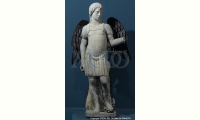 ca. 1560
ca. 1560
Marble, h. 106 cm.
Provenance: Orvieto, cathedral, facade
Restoration: Maura Giacobbe Borelli, 2007, financed by the Fondazione Cassa di Risparmio di Orvieto
Erroneously attributed by Garzelli, following Fumi, to Vincenzo Pacetti, the statue was commissioned from Montelupo in the decade 1555 to 1565, when he was capomastro of the cathedral workyard. It was to be set as "frontispiece above the third door towards the church of San Giacomo" and must have just been finished when on May 28, 1561 copper for the wings and gold leaf for gilding, in line with the other statues on the facade, were bought.
It was removed in 1816 for restoration by the master stone cutter Camillo Cardinali of Orvieto who partially reintegrated the arms and hands. In 1964 it was replaced by a copy and removed to the museum. It is interesting to compare it with a similar statue made by Raffaello da Montelupo in 1544 for the top of Castel Sant'Angelo in Rome, an iconographic precedent for the Orvieto sculpture.
Venetian school
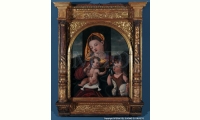 Madonna and Child with the Infant St. John the Baptist
Madonna and Child with the Infant St. John the Baptist
16th century
Oil on wood; 48 x 39 cm.; carved and gilded aedicule frame
Restoration: ICR - Costanza Mora, 1986-2007
The traditional iconographical scheme of this devotional painting with the baby Jesus and the infant St. John with his lamb reflects a frequently encountered composition by the Venetian artist Giovanni Bellini (1430-1516) and his followers.
Santi di Tito (attr.)
(Borgo San Sepolcro 1536 - Florence 1603)
Saint Jerome in the Desert
Oil on wood; 60 x 45 cm.
Restoration: Ditta Giartosio, 2003, financed by the Fondazione Cassa di Risparmio di Orvieto
The iconography is typical for the penitent Saint Jerome, who is shown kneeling before the Crucifixion, holding the stone with which he strikes his breast. The book is an attribute that refers to the Vulgate, Jerome's translation of the Sacred Scriptures, authorized as the official Latin text by the Council of Trent (1545-1563).
The traditional attribution to Santi di Tito is based on evident analogies in style and composition with the painting made by the artist in 1599 for the Roman church of San Giovanni dei Fiorentini.
Jacopo da Bologna (?)
(Bologna ca. 1465 - Rome ca. 1516)
 Madonna and Child with Saint Juvenal and Saint Sabinus; Blessing Christ between two angels (in the lunette); three stories of Saint Juvenal (in the predella): Juvenal consecrated bishop by Pope Damasus, Preaching to the people of Narni, Suicide of a pagan who had attacked the saint
Madonna and Child with Saint Juvenal and Saint Sabinus; Blessing Christ between two angels (in the lunette); three stories of Saint Juvenal (in the predella): Juvenal consecrated bishop by Pope Damasus, Preaching to the people of Narni, Suicide of a pagan who had attacked the saint
15th/16th century
Tempera and gold on wood; lunette 108 x 215 cm., trabeation (horizontal portion below the lunette) 50 x 253 cm., central panel 193 x 185.9 cm., predella (or base) 45 x 246.5 cm
Provenance: Orvieto, church of San Giovenale, high altar; in the Museum since 1882
Restoration: Giovanni Mancini, 1965; Cooperativa C.B.C., 2007, financed by the Fondazione Cassa di Risparmio di Orvieto
The altarpiece, previously damaged in the central panel, comes from the church of San Giovenale which was originally also dedicated to Saint Sabinus of Canosa di Puglia who appears in the central panel next to the Madonna with Saint Juvenal on the other side. The uneven quality of the painting clearly indicates that it is the work of more than one painter. In his 1972 catalogue Garzelli gives the scene in the lunette to Antonio da Viterbo known as il Pastura, and the predella scenes to Francesco d'Avanzarano. Both artists were present in Orvieto in the cathedral workyard during the last decade of the fifteenth century. More interesting is the reference in recent studies to the sphere of Jacopo da Bologna, also documented in the cathedral between 1485 and 1495. It as been proposed that his still uncertain artistic activity may coincide with that of Jacopo Ripanda, fellow countryman and painter of Umbrian-Pintoricchio descendance and an antiquarian culture, wood carver and skillful draftsman, to whom numerous decorative undertakings in the Rome of Alexander VI and Julius II have been assigned.
Luca Signorelli (?)
(Cortona, ca. 1445-1523)
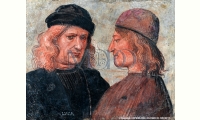 Portrait of Luca Signorelli and the chamberlain Niccolò d'Agnolo Franchi
Portrait of Luca Signorelli and the chamberlain Niccolò d'Agnolo Franchi
1503 (?)
Tempera on terracotta; 32 x 40 cm.
Inscriptions: LVCA, NICOLAVS (on the front); LVCAS SIGNORELLVS. NATIONE YTALYS (!) . PATRIA C[ORTO]/NENSIS. ARTE [PICTO]R EXIMIVS. MERITO APELLI CONPA/RANDUS SUB REGIMINE ET STIPENDIO NICOLAI FRA[N]CHI / EIUSDEM NATIONIS PAT(RIE URBEVE)TANE. CAMERARII / FABRIC[E] HUIUS BASYLICE . SACELLUM HOC VIRGINI DI/CATUM IV[D]ICII FINALIS ORDINE FIGURATUM PERSPICVE P[I]/NSIT [C]VPIDVSQUE IMMORTALITATIS VTRIVSQUE EFFIGIEM / A TERGO LITTERARVM HARVM NATURALITER MIRA EFFINSIT / ARTE. ALEXANDRO VI. PON. M[AX]. SEDENTE. ET MA[XI]MIANO. IIII. INPERAN[TE] ANNO SALUTIS. M / CCCCC. TER[T]IO KALENDAS IANVARIAS. (on the back)
Restoration: Cooperativa C.B.C., 2007, financed by the Fondazione Cassa di Risparmio di Orvieto
The portraits, as identified by the inscription at the bottom, are Luca Signorelli, who painted the frescoes in the San Brizio Chapel between 1499 and 1504, and the chamberlain Niccolò d'Agnolo, in office during that time. It therefore celebrates the two 'protagonists' of the decoration of the chapel. Ever since its appearance in nineteenth-century literature, the authenticity of the work had never been questioned until 1953 when in the Florentine exhibition dedicated to Signorelli, Roberto Longhi maintained that it was a nineteenth-century forgery. The ensuing lively debate is still in course. There are various elements, beginning with the subject and the format, that do seem to be perplexing. At the same time, the quality and brushwork seem to be coherent with a date of around 1500. Recent scientific analyses have also established that the terracotta on which it is painted is compatible with that date. Various characteristics of the text and inscription on the back indicate that this was added later. The fact that it is upside down with respect to the painting might be due to the way in which it was exhibited on a structure where it was turned on a latitudinal axis.
Antonio da Viterbo known as Pastura (attrib.)
(Viterbo, ca. 1450 - before 1516)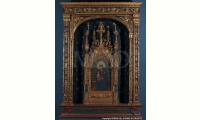 Madonna Enthroned and Child
Madonna Enthroned and Child
Late 15th century
Tempera on wood; 60 x 35 cm.; frame and tabernacle in carved, painted and gilded wood
Restoration: painting, ICR - Arabella Bertelli De Angelis, 2007;
frame, ICR - Paolo Scarpitti, 2007
The painting is set in an elegant carved gilded and polychromed frame, indicative of a Venetian-Adriatic area, inserted into a tabernacle with an incomplete inscription on the lower edge mentioning the names of Baldassarre Leonardelli, chamberlain of the Opera del Duomo, and his wife Felice. We know from Leonardelli's will that around 1848 he had a chapel dedicated to all the saints and the deceased built in the cathedral. It was set against the right wall of the transept, between the fourteenth-century railings and the Cappella Nova (San Brizio chapel). The inscription in the tabernacle is the only thing that ties the name of the noble Orvieto family to this composite rather problematical object for which there are no documents concerning the three stylistically incongruent constituent elements. The painting has traditionally been attributed to Pastura who was active in the cathedral workshop from 1489 on, but in view of the structure and depth of the frame the panel could have replaced a previous image that was probably in relief. Recent restoration has also revealed that the splendid frame with the figurines of the resurrected Christ flanked by half figures holding the symbols of the Passion on the pinnacles constitutes the central compartment of an articulated polyptych, not otherwise documented and of which the other parts have been lost.
Amilcare Galeotti
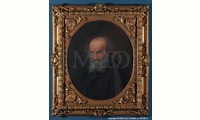 (Orvieto, 1832 - after 1898)
(Orvieto, 1832 - after 1898)
Portrait of Andreino Galeotti
Late 19th century
Oil on canvas; 56 x 44 cm.
Donated on May 14, 1912 by Andrea and Edmondo Galeotti and Ida Travaglini
Restoration: Francesco Lanzetta, 2007, financed by the Fondazione Cassa di Risparmio di Orvieto
This painting was donated together with the painter's Self-portrait. His father Andreino (Cortona ca. 1800 – Orvieto after 1885) was an architect of neo-classic training. After settling in Orvieto he worked here on the projects for the Palazzo Mazzocchi, the church of Sant'Angelo and the city hall in Bolsena.
Amilcare Galeotti
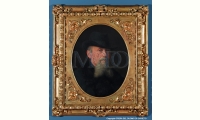 (Orvieto, 1832 - post 1898) 66
(Orvieto, 1832 - post 1898) 66
Self-portrait
Dated on the back 1898
Oil on canvas; 56 x 44 cm
Donated on May 14, 1912 by Andrea and Edmondo Galeotti and Ida Travaglini
Restoration: Francesco Lanzetta, 2007, financed by the Fondazione Cassa di Risparmio di Orvieto
The painting was given to the Opera by the artist's descendants. Amilcare, son of Andreino, painter and architect from Cortona, worked with his father on the decoration of the Mancinelli theater between 1863 and 1866 under the direction of Annibale Angelini (1810-1884) from Perugia, and Cesare Fracassini (1838-1868), Roman of Orvietan origins.
Santo Varni
(Genoa 1807-1885)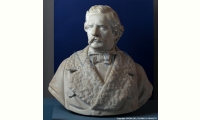 Filippo Antonio Gualterio
Filippo Antonio Gualterio
1874, after/ 1885 before
Marble; h. 70 cm.
Donated in 1908 by Enrico Gualterio
Marchese Filippo Antonio Gualterio (1819-1874) was an Orvietan patrician and illustrious statesman in the Italy of the Risorgimento (1815-1871) and newly unified Italy (1861). Already committed to the neo-Guelph and Giobertian reform movement, he was elected deputy in 1860. Subsequently he was prefect of Perugia, of Genoa, of Palermo and Naples and, senator in 1861, he was called to the government in 1867 as Minister of the Interior and as his last office Minister of the Royal House. Another of his interests was history, including that of Orvieto.
The bust was donated to the Museum in 1908 by his son, Admiral Enrico Gualterio, and is an example of the mature work of Santo Varni. Varni was a key figure in the art world of nineteenth-century Liguria and achieved great fame as the official sculptor for the House of Savoy. Of particular note among his works is the creation in 1849 of the Floating Catafalque for the transportation of the body of Charles Albert, king of Sardinia, via ship from Portugal to the Ponte Reale in Genoa. Also noteworthy are the busts of Maria Adelaide, Maria Clotilde, Maria Pia, Maria Teresa, Vittorio Emanuele II and Umberto I; and lastly, the statue of Duke Emanuele Filiberto, commissioned by Vittorio Emanuele II.
Of academic training, Varni successfully adapted the neo-classic-purist iconographic tradition to the new historical-celebrative and political subjects, endowing the portraits with intimist and sentimental reflections, still of a Romantic matrix.
Giovanni Duprè
(1817-1882)
Lodovico Gualterio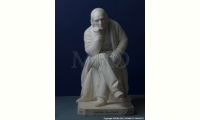 1779-1852
1779-1852
1853 (dated and signed)
Marble; h. 56 cm.
Inscriptions: documentary – on the front, on the base: 1779 LODOVICO GUALTERIO 1852;
commemorative - on the back side: CATTOLICO SENZA IPOCRISIA/ CARITATEVOLE SENZA IATTANZA/ AMO' LA PATRIA SENZA AMBIZIONE;
documentary –on the back side, on the base: G. DUPRE'. F.A. 1853
Restoration: Ditta Maura Borelli Giacobbe, 2006
Donated by the Gualterio family to the Opera del Duomo in 1908, Marchese Lodovico is shown seated in a natural pose of thoughtful reflection. Lodovico Gualterio was the father of Filippo Antonio, senator and Minister of the newly unified kingdom of Italy, and probably the person who commissioned this portrait from Duprè with whom he was personally acquainted.
The work, dated and signed, in addition to formal and compositional aspects derived from Lorenzo Bartolini, reflects the artist's adhesion to the purist (neo-Gothic and neo-Renaissance) aesthetics, the result of his contacts in Rome between 1844 and 1845 with Tommaso Minardi and Pietro Tenerani. It was at this time that Duprè became involved in the liberal-moderate and neo-Guelph political world, to which Gualterio, a follower of Gioberti, the Italian philosopher and politician, whose writings helped bring about the unification of Italy, also belonged.
Agostino Cornacchini 69
(Pescia, 1686 - Rome, 1740)
Guardian Angel
ca. 1722
Terracotta; h. 36 cm.
Donated in 1881 by the canon Girolamo Saracinelli
Restoration: Giovanni Manuali, 2007
Like the other maquette (n. 70) by Cornacchini, this one is also missing some parts. Restoration has however given us the lovely figure in the softness of the careful modeling, accentuated by the exceptional plasticity of the clay. This was the model for the marble companion piece to Saint Michael Archangel in the chapel of the Corporal in the cathedral. The iconography was inspired by the story of Tobias and the Archangel Raphael. Both statues were commissioned in December 1722, but the guardian angel was finished two years later, in November 1729.
The theme of the guardian angel was popular beginning with the late sixteenth century and often, as confirmed here in Orvieto, frequently had an Archangel Michael as companion piece.
Agostino Cornacchini 70
(Pescia, 1686 - Rome, 1740)
Saint Michael Archangel
ca. 1722
Rosin (Greek pitch); h. 54 cm.
Restoration: Giovanni Manuali, 2007
The general aspect and fine modeling of this elegant study or maquette, damaged in various parts, including the arms, for the marble statue in the chapel of the Corporal, has recently been restored. The figure illustrates a passage from the Apocalypse, describing the archangel struggling with the devil.
Together with the corresponding Guardian Angel, the statue was commissioned in December 1722 and was finished in August 1727. This period was one of intense activity for the sculptor in some of the most important Roman churches, in particular Saint Peter's.
Bernardino Cametti
(1669-1736) 71
 Saint James the Less
Saint James the Less
ca. 1715
Plaster; h. 75 cm.
Restoration: Francesco Lanzetta, 2007, financed by the Fondazione Cassa di Risparmio di Orvieto
The plaster maquette, of which the face has been lost and with a missing right forearm, was a study for the marble statue Cametti made between 1714 and 1722 for one of the apostles in the nave of the Orvieto cathedral. It may have been preceded by an earlier version, perhaps smaller, mentioned in the contract for the statue of June 1714.
The figure closely resembles the Saint James Major that Camillo Rusconi (1658-1728) made in 1715 for San Giovanni in Lateran. It is unclear if this correspondence depends on the fact that both artists used the same model, the Belvedere Apollo of classical antiquity, or if there was a relationship between the two artists.
Bernardino Cametti
(1669-1736) 72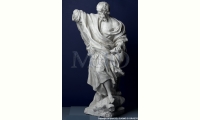 Saint Simon
Saint Simon
ca. 1715
Plaster; h. 80 cm.
Restoration: Francesco Lanzetta, 2007, financed by the Fondazione Cassa di Risparmio di Orvieto
Like the Saint James the Less (n. 71) this was also a model for the large marble statue for the nave of the cathedral and was probably preceded by an earlier study, mentioned in the contract of June 1714.
Vincenzo Pacetti (?) 73
(Rome, 1746-1820)
Hermaphrodite
after 1781
Wax with the addition of terracotta powder, plaster; l. 42 cm.
Restoration: Ditta Maura Borelli Giacobbe, 2006
In the soft forms of a lustrous wax impasto, this small sculpture is a reproduction of the Roman first century A.D. statue – in turn a copy of a Greek original by Polycleitos of the second century B.C. - which turned up in 1781 in the quarry of Monte Compatri, in the Borghese feud. Restored that year by Vincenzo Pacetti, it entered the Borghese collection replacing the more famous Greek statue – previously belonging to Cardinal Scipione who had had Bernini sculpt a base for it in the form of a quilted pallet, which is now in the Louvre. Pacetti was an extraordinarily important figure in the Rome of the Grand Tour as sculptor, restorer and antiquarian in touch with the international world of antique collectors, and in Orvieto he collaborated, on the order of Cardinal Braschi and under the direction of the papal architect Giuseppe Valadier, in the restoration of the facade of the cathedral, damaged by lightning in 1795, supervising the replicas of the five statues that had been destroyed.
The "small model" of the Hermaphrodite is documented in the inventory of the cathedral sacristy in 1833, mentioned in Francesco Pennacchi's Guide to Orvieto of 1873 among the art objects on view in the "Casa dell'Opera" and subsequently present as unknown in the catalogues of the newly founded Museum. In the absence of exact documentary references that testify to the real paternity of the work, the high quality of the modeling and its closeness to the antique model denote that profound understanding and habitual respect for the formal and expressive values of the classical language of antiquity for which Pacetti and his busy workshop were known. Their production of "souvenirs" and models of antiquities was well known and documented.
Cesare Fracassini
(1838 -1868) 74
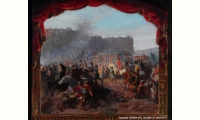 Belisarius Frees the City of Orvieto from the Goths
Belisarius Frees the City of Orvieto from the Goths
1864
Oil on canvas; 44 × 51 cm.
Sketch for the stage curtain of the Mancinelli theater in Orvieto
Provenance: Orvieto, Teatro Mancinelli
Restoration: Ditta Maura Borelli Giacobbe, 2006
This crowded and dynamic scene describes the historical episode of 535 A.D. narrated by Procopius di Cesara in De bello gotico when the Byzantine general Belisarius freed the city of Orvieto from the Goths. The hazy cliff of Orvieto acts as backdrop, and swift brushstrokes give color and light to the scene, in an expressive style influenced by verism or realism.
The painter's family was from Orvieto but he received his academic training in Rome, pupil of Tommaso Minardi. At the time already a well-known artist in Rome, in 1863 the "Consorzio Teatrale" of Orvieto commissioned him with "the historical paintings" of the theater and "the telone".
The sketch for the stage curtain was presented in March 1864 and illustrated a subject proposed by one of the artist's friends, who was also president of the association, Count Tommaso Piccolomini.
In 1887 the Consorzio donated the sketch to the Museo dell'Opera.
Giacomo Pierucci (attr.)
(active in Orvieto in the second quarter of the 17th century)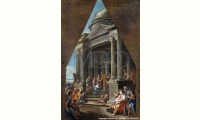 Presentation of Mary at the Temple
Presentation of Mary at the Temple
Second quarter 17th century (?)
Oil on canvas; 64 x 42 cm.
Restoration: ICR - Carla Zaccheo (docent) e Ilaria Scacchetti (pupil), 1997
The two triangular areas covering the upper corners of this small painting marked the shape of the gable into which the mosaic was to be set. To be noted is a white measuring line along the upper right edge. This is the preliminary painting for the mosaic in the right gable of the facade of the cathedral. According to Fumi it is by Giacomo Pierucci, who around 1648 completed the painting of the Marriage of the Virgin, left unfinished by Gabriele Mercanti, and then painted the Annunciation below, between 1649 and 1650. The Presentation replaced an earlier mosaic with the same subject made by the Orvietan Pietro di Puccio in June 1376 and signed.
Venetian-Adriatic school
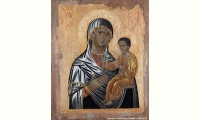 Mother of God "Theotokos Odigitria"
Mother of God "Theotokos Odigitria"
18th century
Tempera and gold on wood; 78 x 65 cm.
Provenance: Orvieto, Hospital
Restoration: ICR - Costanza Mora, Beatrice Provinciali, 1986-2007
Image of Byzantine derivation, formerly considered a late copy of the icon Pope Gregory IX had transferred in 1235 from the Lateran to Santa Maria del Popolo in Rome.
The traditional iconography is that of the Theotokos Odigitria or Mother of God, She who points the way, with the Virgin indicating the Child, who is holding the scroll of the Law, as the way to salvation. The frontal and hieratic position of the figure is simplified in the garments of the Madonna and the regal himation of the Child. Recent restoration has given the figures and the gold ground with the punched patterns of the halos their original clarity.
Venetian-Adriatic school
 Mother of God "Theotokos Odigitria"
Mother of God "Theotokos Odigitria"
17th/18th century
Tempera and gold on wood; 72 x 60 cm.
Restoration: ICR - Costanza Mora, Beatrice Provinciali, 1986-2007
The iconography of this Theotokos Odigitria, Mother of God. She who points the way" as she indicates the Savior is traditional. Together with the preceding (n. 76) it is thought to be an icon of Byzantine derivation that repeats and simplifies, in its formal values, older models from various provenances. The composition is similar, while the addition of the two angels crowning the Virgin at the top is an innovative and late element.
Central Italian painter
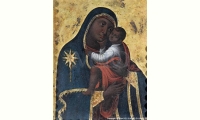 Madonna of Carmelo
Madonna of Carmelo
17th century
Tempera and gold on copper; 23.5 x 18.5 cm.
Provenance: Orvieto, confraternity of the Carmine
Restoration: Francesco Lanzetta, 2007, financed by the Fondazione Cassa di Risparmio di Orvieto
In this traditional and highly venerated subject the painting gives us the oldest known version of the Madonna Bruna or Black Madonna in the shrine of the Carmine Maggiore in Naples, a fourteenth-century icon representing the Mother of God Glykophilousa or Sweet-loving Virgin tenderly holding her Child.
To be noted is the way in which the subject has been turned into a sort of folk art version of the Byzantine iconographic scheme with the formal models emptied of their original valence and used in an archaicizing and devotional way. The figure of the Virgin, covering most of the picture, stresses her human nature as an affectionate mother and this together with the realistic "depiction" of the Christ Child falsifies the dogmatic principals on which the ancient icons were based. The reduction of the gold background also reveals a lack of comprehension, or of interest, in the symbolic and conceptual system which regulated the figure-background relationship in the original.
Venetian-Cretan school
 Christ on the Cross with the Mourning Virgin Mary, Mary Magdalene and St. John the Evangelist
Christ on the Cross with the Mourning Virgin Mary, Mary Magdalene and St. John the Evangelist
Late 16th century
Oil on wood; 34.5 x 29.5 cm
Restoration: Francesco Lanzetta, 2007, financed by the Fondazione Cassa di Risparmio di Orvieto
This small devotional panel is generally attributed to the "Venetian-Cretan" tradition typical of a vast late and post-Byzantine artistic production in Italy, particularly in the Adriatic area. In the sphere of this formula, in which the Eastern artistic tradition continued, the ancient model is time and time again contaminated by new cultural contributions, which in the second half of the sixteenth century, come in particular from Titian and his school.
Ludovico Mazzanti (attr.)
(Orvieto 1686 - Viterbo 1775) Portrait of Count Girolamo Curzio Clementini
Portrait of Count Girolamo Curzio Clementini
Around 1716
Oil on canvas; 74 x 63 cm.
Inscriptions: COMES HIERONYMUS CURTIUS DE CLEMENTINIS GLORIOSAM PREDE/ CESSORUM MEMORIAM FILIIS TRADIT AN/ MDCCIII
OBIIT DIE XII/ APR. 1716
Restoration: Maura Giacobbe Borelli, 2007
Born in Amelia in 1658, Girolamo Curzio Clementini moved to Orvieto around 1680, where another branch of the family had lived since the fifteenth century. Soprastante of the cathedral workshop of Orvieto more than once, he also wrote a detailed description of the cathedral. The date in the inscription refers to the year of his death, the probable date of this portrait. As for its attribution, in addition to the stylistic elements, the relationship between Clementini and Ludovico Mazzanti, commissioned to paint the altarpiece (here at n. 80) for the family chapel, tend to indicate this artist.
Pietro Paolo Sensini (?)
(Todi ca. 1555 – mentioned up to 1632) 82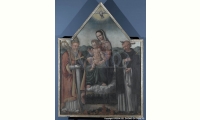 Madonna and Child with Saint Pius V and Saint Peter Martyr
Madonna and Child with Saint Pius V and Saint Peter Martyr
Last two decades of the 16th century
Tempera on wood; 170 x 123 cm.
Restoration: Francesco Lanzetta, 2007, financed by the Fondazione Cassa di Risparmio di Orvieto
In its simplicity of composition and faithfulness to late-Renaissance models in line with the Counter-Reformation dictates, the painting can be compared to some of the artist's early works – including the altarpiece in the Orvieto church of San Giovenale attributed to him and which made him widely popular among the local ecclesiastical authorities.
The subject suggests that it may be of Dominican inspiration, while chronologically of note is the presence of Saint Pius V. He died in odor of sanctity in 1572 and was so quickly venerated that in 1588 Pope Sixtus V moved the body to the monumental tomb in the Roman basilica of Santa Maria Maggiore.
Recent restoration has shown – contrary to Garzelli's suppositions (1972) – that the existence of an earlier painting underneath the one there now can be excluded, as well as the supposition that the panel had been cut down, since the preparatory ground for the painting does not reach the edges.
Workshop of Benedetto Buglioni
Kneeling angel
Early sixteenth century
Glazed terracotta; ca.120 x 90 cm.
Provenance: Orvieto, convent of the Buon Gesù
acquired in 1903
Restoration: early twentieth-century restorer; ICR - Elisabeth Huber, 2007
The terracotta angel comes from the portico wall of the convent of the Gesù although it was not originally there as shown by the curvature of the right edge. It must have been part of a lunette over a portal or an altarpiece. While the attribute of the lily would indicate that it was an angel of the Annunciation, the curvature on the left and the original size of the lunette make it more probable that there was a similar angel on the other side of a central figure in a mandorla, possibly a Christ or blessing God the Father. The lower part of the body seems to have been made after the figure came into the museum.
Parisian goldsmith
Chalice with paten
1887
Gilded and embossed silver, filigree and enamel: Ø base 17 cm.; Ø bowl 10.7 cm.
paten: Ø 15.5 cm.
Donated by Pope Leo XIII to the Opera in 1891, on the sixth centennial of the foundation of the Orvieto cathedral
Restoration: : Maura Giacobbe Borelli, 2007, financed by the Fondazione Cassa di Risparmio di Orvieto
As documented by the Latin inscription on the base, the chalice, used to offer the wine in Communion, was donated by the clergy of Orléans to Pope Leo XIII in 1887 on the fiftieth anniversary of his ordination. The Parisian hallmark for silver used in 1838 and that of the goldsmith, still unidentified, are engraved on the rim. Both the enamels of a troubadour taste and the use of filigree reflect the profound renewal of the transalpine goldsmith's work imparted by Placide Poussielgue-Rusand (1824/1889), inspired by medieval art.
The paten was used to hold the Eucharistic bread or wafer.
Roman goldsmith
Chalice
1831 - 1841
Cast, gilded and embossed silver; h. 29 cm.; Ø base 13.5 cm.; Ø bowl 9.2 cm.
Restoration: Maura Giacobbe Borelli, 2007, financed by the Fondazione Cassa di Risparmio di Orvieto
The three medallions on the base contain images of the three theological virtues. They are faithful copies of those on the predella of Raphael's Baglioni Altarpiece. Three stories of Christ's Passion are depicted in the medallions on the bowl. The coat of arms of Pope Gregory XVI (1831-1846), who donated the chalice and paten in 1841, is impressed under the foot. The certification stamp (bollo camerale) in use between 1815 and 1870 and the silversmith's hallmark, unidentifiable, are impressed on the edge.
Roman goldsmith
Chalice and paten
1761 - 1769
Gilded, repousse and embossed silver; h. 29 cm.; Ø base 15 cm.; Ø bowl 9.5 cm.
Restoration: Maura Giacobbe Borelli, 2007, financed by the Fondazione Cassa di Risparmio di Orvieto
The coat of arms of the Ripanti family is under the foot, allowing the donor to be identified as Antonio Ripanti, bishop of Orvieto from 1762 to 1780. Both certification stamp and the goldsmith's hallmark are on the edge of the bowl. The latter cannot be deciphered but the former – with the papal umbrella and keys in an oval – is of the type that began to be used in 1744. Even so the stamp used here is closer to those used between 1761 -1769. The iconography alludes to the redeeming sacrifice of Christ.
Central Italian goldsmith
Box
ca. 1926
Embossed and engraved silver
Inscription: CIVI. PRAECLARISSIMO/ CARD. BONAVENTURAE. CERRETTI/ CURATORES. MUNICIPII. URBEVETANI/ EPISCOPUS. CLERUS/ POPULUS. UNIVERSUS/ ANN. MCMXXVI
Restoration: Maura Giacobbe Borelli, 2007, financed by the Fondazione Cassa di Risparmio di Orvieto
Neo-renaissance in taste, enriched by elaborate embossed elements arranged in panels and including, on the lid, the coats of arms of the city and of the cardinal, this valuable casket was donated to Bonaventura Cerretti (1872-1933) by the civil and religious community of Orvieto on the occasion of his nomination as cardinal by Pope Pius Xi on December 14, 1925. The Orvietan prelate subsequently donated it to the museum of his home town.
Parisian goldsmith
Thurible
1574-1575
Embossed, openwork, gilded and enameled; h. 27.5 cm.; Ø at the base 10.4 cm.
In the collections of the Opera since 1867
Restoration: Maura Giacobbe Borelli, 2006
Despite the fact that some of the enamels have fallen, the general state of conservation is good. The work of a French goldsmith, it is one of the finest examples of sixteenth-century transalpine goldwork, to be compared with the censer donated by King Henry III to the Order of the Holy Spirit, now in the Louvre and made in1579-80. The goldsmith's hallmark on these two objects is identical and can be associated to two goldsmiths, Jean Jammes and Jean Joly. The coat of arms of a bishop of the Orvietan family Gualterio is under the foot. Various Gualterio members held the office of apostolic nuncio in France.
Thurible case
16th century
Leather stamped in gold; h. 39 cm.
Restoration: Maura Giacobbe Borelli, 2007, financed by the Fondazione Cassa di Risparmio di Orvieto
Leather-covered case lined in red velvet, in the shape of the precious thurible (n. 88) for which it was made. At the top is the Gualterio episcopal coat of arms.
Central Italian goldsmith
Architectural pax
16th century XVI secular
Embossed, engraved, gilded copper
Inscriptions: (trabeation) ECCE AGNUS DEI; (lunette) QUI TOLLIT PECCATA MUNDI
Restoration: Maura Giacobbe Borelli, 2007, financed by the Fondazione Cassa di Risparmio di Orvieto
Liturgical object used for the exchange of the "kiss of peace" before Communion, originating in the Hebrew tradition and adopted by the early Christians as a sign of brotherhood and reconciliation. The use of this object and its production became widespread in Italy between the fifteenth and sixteenth century. It fell from favor during the eighteenth century. This example is characterized by its architectural structure in the form of an altarpiece and includes the typical depiction of a subject from Christ's Passion, in this case a Deposition of Christ and mourners, set into the figured plaque, and a Resurrected Christ in the arched pediment, crowned by what remains of a fragmentary bust. On the back, a small volute-shaped handle served too hold or support the object.
Florentine
Pair of cruets
Late 16th – early 17th century
Cast and gilded bronze, silvered metal and glass; h. 13 cm.; Ø base 4.2 cm.
Documented in the collections of the Opera at least since 1880
Restoration: Maura Giacobbe Borelli, 2007, financed by the Fondazione Cassa di Risparmio di Orvieto
The wine cruet, with a 'V' (for vinum) incised inside the spout, has lost its handle. The ornaments on the sides of the one for water are very worn. The center of production of objects of this type has been identified as Florence since they were widespread in Tuscany and are cited in some of the sources. There is an example of similar make in the church of San Domenico in Prato. It is not known when this elegant pair of cruets arrived in Orvieto.
Lorenzo de Marchis
(doc. 1604-1629)
Hanging lamp
First quarter 17th century
Embossed silver; h. 27 cm.
Provenance: Orvieto, cathedral, chapel of the Raccomandati
Restoration: Maura Giacobbe Borelli, 2007, financed by the Fondazione Cassa di Risparmio di Orvieto
The lamp, well-made, was heavily oxidized and some of the openings were broken and showed signs of old, crude restoration. Recent restoration has remedied this state of affairs and reintegrated some of the detached fragments There are two dies inside the hook (check); the certification stamp and the hallmark of the silversmith Lorenzo de Marchis: a nursing wolf. The activity of de Marchis is documented from 1604 to 1629, the year of his death.
Orvietan cabinetmaker (?)
Voting box
18th/19th century
Carved, painted, partially gilded wood
Restoration: Roberto Saccuman, 2007
This elaborate structure consists of a cylindrical collector and a container with two handles with two drawers marked "SI" and "NO" on the lower part and with a wide opening through which to insert the votes (white and black beans), separated inside by a partition. It was used to collect the votes of the old Fabbriceria of Orvieto – and has the coat of arms of the city and of the bishop. This container is of a type used by municipal governments, bodies or confraternities as early as the first half of the sixteenth century.
Orvietan cabinetmaker (?)
Box
Second half 16th century (?)
Carved painted wood; 18 x 63 x 38.5 cm.
Restoration: Roberto Saccuman, 2007
The box rests on four lion-paw feet. The coat of arms of the Opera del Duomo with the letters OPSM (Opera Pia Sancte Marie) in a Greek cross is on the front side. It is repeated on the lid. The fact that there is a removable shelf inside, divided into compartments, seems to indicate that it was used in the records office of the Opera.
Central Italy
Casket
Last quarter 14th century
Painted and partially gilded wood and gesso, brass; 22 x 42 x 16.5 cm.
Provenance: Orvieto, cathedral
Returned to the Museo dell'Opera in 1880 by the bishop Antonio Briganti
Parts of this box are missing. The molded base has been lost on three sides. A few of the relief figurines have been damaged and one of the knights is almost entirely lost. Both the hinges and the lock are later, for the cover must originally have simply been set on the box. It might correspond to a gift made to the Fabbriceria in 1441. The scenes of a courtly secular nature, difficult to interpret iconographically, suggest a non-religious use. It was used in the cathedral treasury as a container for relics.
North Italian (Venice or Ferrara ?)
Casket with mythological scenes
First half 16th century
Carved wood, gilded and white pastille; 7 x 12.5 x 8.5 cm.
Acquired in 1907 from Ferdinando Bonoso
This type of object was widespread to which their 'industrial' quality implicitly bears witness. On the front is the Fall of Icarus and Apollo and Daphne; on the left side Two women followed by two satyrs; on the right side An elephant with two fighting warriors; on the back Orpheus enchanting the animals.
Originally the casket was unquestionably of a secular nature.
Northwestern Alps
Case
18th century
Chip-carved walnut; 12 x 12 x 4 cm.
Restoration: Roberto Saccuman, 2007
This small wooden case decorated with geometric motifs typical of the Alpine craftwork, has a sliding door with a pyramidal handle. The interior is divided into two sections. It might be a common object originally for secular use , later reused in a religious sphere as a container for relics or vials of holy oil.
Near East
Eulogy cruet
12th-13th century
Carved engraved ivory; h. 9 cm.
Restoration: Maura Giacobbe Borelli, 2007, financed by the Fondazione Cassa di Risparmio di Orvieto
This small pear-shaped container has a lid, perhaps originally with a leather hinge, and two rings at the sides of the opening for a leather tie. It was probably meant to be used as a sort of reliquary for various materials collected in pilgrimage sites, such as dust, sand or grains of Holy Earth, oils that burned on the tombs of martyrs, substances that had been exuded from the tombs of saints. Popular devotion attributed miraculous or apotropaic powers to "relics" of this kind, as expressed in the Greek term euloghia, or benediction.
Spanish or Siculo-Arabic
Casket
12th-13th century
Polychrome (Painted with ???) ivory and brass; 7.5 x 12 x 8
The casket, if authentic, could be the gift made to the cathedral in 1441. It belongs to a fairly common type of casket known as 'Siculo-Arabic'. There are however incongruities in this Orvietan example. The metal parts as well as the painted medallions were probably later additions.
Central Italian cabinetmaker (?)
Small box
13th-14th century
Carved and painted wood; 12 x 27 x 11 cm.
Provenance: Orvieto, cathedral, chapel of the Raccomandati
Restoration: Roberto Saccuman, 2007
The lid is missing from this small wooden box, decorated on the front with two symmetrical panels containing two animals in plant volutes.
Umbrian goldsmith
Processional cross
Late 16th century
Copper-gilt with medallions in embossed silver leaf; 44 x 33,5 cm.
In the Museo dell'Opera since 1881, gift of the bishop Antonio Briganti
Restoration: Maura Giacobbe Borelli, 2007, financed by the Fondazione Cassa di Risparmio di Orvieto
On both sides, in addition to the five four-lobed medallions, the cross has a sixth rhomboid-shaped plaque halfway down the lower stretch of the vertical arm, of a type common in Umbrian crosses. The iconographic program of the subjects depicted is centered on the themes of redemption and exaltation of the Dominican order. On the back is the coat of arms of the Orsini of Pitigliano. In identifying the original patrons and provenance, it should be noted that the three natural daughters of Count Nicola Orsini (1500-1594) were nuns in the Dominican convent of San Pietro in Orvieto.
Italian
Multiple altar bell Sanctus bell
17th century
Openwork bronze, silver; h. 11.5 cm.; Ø 11.5 cm.
Provenance: Orvieto, cathedral, chapel of the Raccomandati
In the Museum since 1888
Restoration: Maura Giacobbe Borelli, 2007, financed by the Fondazione Cassa di Risparmio di Orvieto
Inside there are four spherical silver bells with an incurving opening, some of which are broken. It is probably because of their characteristic form that when the object was deposited in the Museum in 1888 it was described as "medlar bell", resembling the fruit. Like the single bells, the multiple bells, known in the French term as carillon or quadrille, were used during the celebration of the mass at the moment of the Sanctus and the Elevation.
Rhine-Meuse area (?)
Reliquary cross (known as "of Bagnoregio")
Second quarter 13th century
Gilded embossed silver, filigree, pietre dure and colored glass; h. 25 cm.; l. 17 cm.
Donated in 1891 by the canon Girolamo Saracinelli
Restoration: Maura Giacobbe Borelli, 2007, financed by the Fondazione Cassa di Risparmio di Orvieto
The extremities of the cross are in trilobate form. The front of the cross is decorated in filigree with colored stones and glass, most of which are probably not original. A cross-shaped opening at the crossing of the arms housed a relic, probably of the true cross. The back is smooth and with five small plaques: the mystic lamb is at the crossing, and the symbols of the four Evangelists, the eagle (John), the angel (Matthew), the lion (Mark) and the ox (Luke), are at the ends.
The technical characteristics make it hard to identify the area where the cross was made, somewhere between the Rhine-Meuse the Venetian area. A date near the middle of the thirteenth century seems to be most probable.
Central Italian goldsmith
Processional cross
Mid-15th century
Chased gilt copper, engraved silver, translucent enamel; h. 21.7 cm.; l.18.5 cm.
Restoration: Maura Giacobbe Borelli, 2007, financed by the Fondazione Cassa di Risparmio di Orvieto
The arms of the cross have trilobate terminations in which on the front there are engraved silver tondos depicting the Virgin, St. John the Evangelist and a Bishop Saint. The lower tondo with Saint Mary Magdalene mentioned in the early twentieth century document has been lost. The three half-bust figures present slight traces of green and blue enamel. The crucified Christ calls to mind fourteenth-century models. The object has some elements in common with goldsmith objects produced in upper Lazio.
Sienese goldsmith
Chalice
Second quarter 15th century
Chased copper, incised and gilded, and translucent enamel on silver; ht. cm. 18,5; Ø base cm. 12,3; Ø bowl 8,3 cm.
Inscription (under the foot): fabio de lotto da bardano santese dela madonna del piano 1587
Restoration: Maura Giacobbe Borelli, 2006
The bowl of the chalice is not original and the inscription 1587 under the foot might also be indicative of the date of the chalice. The six silver plaques on the knob were originally covered in translucent enamel. They depict a Pietà with Christ between Mary and St. John the Evangelist, a bearded Saint with a scroll, Saint Peter and the Orvietan Benincasa coat of arms. The style of the plaques indicate a Sienese goldsmith.
Umbrian painter (?)
Processional cross
Last third of the 16th century
Oil on wood; 38.5 x 28 cm.
Restoration: Francesco Lanzetta, 2007, financed by the Fondazione Cassa di Risparmio di Orvieto
The cross has mixtilinear circle terminations and is painted identically on both sides. The iconography with Saints Bernardino and Andrew at the ends of the horizontal arm is unusual. The style seems to indicate a late sixteenth-century Umbrian sphere of influence.
Central Italian cabinetmaker
Crucifix
fragment
17th century
Carved boxwood
Restoration: Roberto Saccuman, 2007
This fragmentary cross, refined in its execution and with a sensitivity for the sculptural forms, depicts the Crucified Christ in the typical "patiens" iconography, prescribed and promoted in post-Tridentine times. Of particular note is the quality of the relief, incisive and well formed, the peaceful expression of the suffering face, eyes closed, and the head hanging down on his shoulder as well as the attention to anatomy.
Lower Rhine
Basin
12th century
Embossed and engraved metal; h. 4.5 cm.; Ø 25.8 cm.
Restoration: Maura Giacobbe Borelli, 2006
The coat of arms of the Opera di Santa Maria is engraved beneath the foot of the basin. Inside the bowl an inscription identifies the five engraved figures of the vices. In the center is Superbia surrounded by Ira, Luxuria, Idolatria and Invidia. Near the outer edges, in groups of three, are the names of the other twelve vices: Malicia, Inmunditia, Ebrietas / Crapula, Fraus, Emulatio / Contentio, Ambitio, Suspitio / Odium, Peccatum, Dolus.
Previously considered a typical artifact of the Hanseatic cities (therefore defined as Hansaschüssel), this type of basin is now considered a product of a rather broad area in the lower valley of the Rhine between the twelfth and thirteenth century. There is a large iconographic repertory. There are many with depictions of the virtues and vices, often used in pairs, probably in women's convents, for the ritual ablutions.
Franciscan sphere of influence
Crucified Christ and Saint Francis / on the back, Madonna and Child
17th century
Oil on copper; 16.5 x 11.5 cm.
Restoration: Francesco Lanzetta, 2007, financed by the Fondazione Cassa di Risparmio di Orvieto
This small devotional painting was meant to help the viewer meditate on the sacrifice of Christ, stimulated by this particularly expressive Crucifixion. The image of the Madonna on the back betrays its Eastern origins.
German
Table cross
16th century
Sculptured ivory, carved wood, embossed and engraved silver; h. 35 cm.
Tordi donation 1933
Restoration: Maura Giacobbe Borelli, 2003, financed by the Fondazione Cassa di Risparmio di Orvieto
Traditional iconography of the Christus patiens in this elegant ivory sculpture. The details and the expressiveness of the features seem to indicate a Nordic craftsman, with an original and refined style, to be seen in the quiet suffering of the head hanging down on the shoulder and the search for incisive anatomical details.



